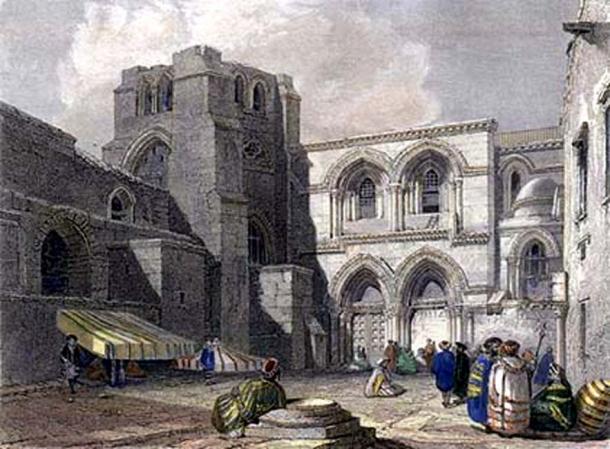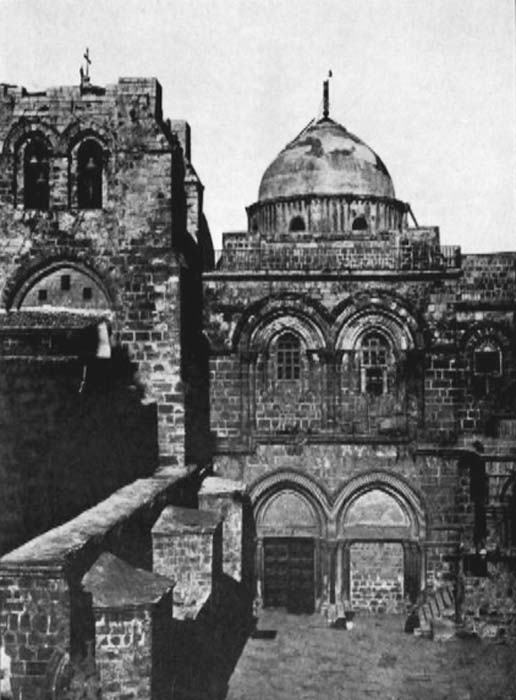The Immovable Ladder is an ordinary wooden ladder with an extraordinary history. It was placed under a window on the exterior of the Church of the Holy Sepulchre in the Old City of Jerusalem and, due to a long-running feud, has remained there for close to three centuries.
The Immovable Ladder has great symbolic value attached to it, as it has been commonly taken to signify the divisions within the Christian faith, in particular between the Catholic and Orthodox Churches, as well as those within the Eastern Churches. This is even more poignant, considering the ladder’s location at the holiest site in Christendom.

1834 engraving of the entrance to the Church of the Holy Sepulchre. ( Public Domain ) The Immovable Ladder can be seen under the upper right window.
Unanswered Questions on the Immovable Ladder
The Immovable Ladder rests on a ledge under one of the windows on the external part of the church’s second floor wall. The origin of the Immovable Ladder is rather murky. No one knows for sure today why it was placed there, when it was placed there, and, perhaps most importantly, who placed it there.
Some sources state that references have been made to the Immovable Ladder as early as 1757, though these are shrouded in uncertainty. Photographs and lithographs of the church produced during the middle of the 1850s have the Immovable Ladder depicted in them. By this time, however, the ladder had already become a mystery, and no one could provide satisfactory explanations for its presence.

Church of the Holy Sepulchre in 1885. The Immovable Ladder is visible below the upper-right window. (A different ladder is silhouetted against the dome.) ( Public Domain )
About the same time, in 1852/3, the Ottoman Sultan, Abdülmecid I, issued a firman (an announcement of the law which corresponds to an ‘edict’) that the Church of the Holy Sepulchre was to be shared between the Greek Orthodox Church, the Roman Catholic Church, and the Armenian Apostolic Church. In addition to that, three other churches – the Coptic Church, the Syrian Church, and the Ethiopian Orthodox Church, were also given the rights to use certain areas of the church.
According to one story, it was after this firman was issued that the ladder was placed. The ladder was called ‘Immovable’, as no one church could move it without the agreement of the other five, which in turn is a reflection of the divisions within Christianity.

Ottoman Sultan, Abdülmecid I. ( Public Domain )
Clashes Arise if the Ladder Moves!
Alternatively, the Immovable Ladder may be taken to be a message of Christian unity. According to this interpretation, the ladder may be taken as a sign that the Church of the Holy Sepulchre does not belong to one particular denomination of Christianity alone, but to all of Christendom.
Such an understanding of the ladder, however, has not eased the tensions between the custodians of the church, which at times have erupted into blatant acts of violence. In 2008, for example, Israeli riot police were called in to stop a violent clash that broke out between monks from the Greek Orthodox and Armenian Apostolic Churches.

The Church of the Holy Sepulchre. ( CPO /Adobe Stock)
The ‘immovability’ of the ladder is certainly more symbolic than real, as it has already been moved several times in the past. As an example, in 2009, the ladder was moved from the right window to the left one. According to one source, it was thought that this had been done so as to allow the area to be cleaned. Another source, however, claims that the ladder was moved so that the scaffolding that was needed to complete the renovations being made to the bell tower could be cleared away.
The ladder was also moved in 1997, when it was allegedly taken by a mischievous tourist and hidden behind an altar. As tension mounted among the churches, especially between the Greek Orthodox and Armenian Apostolic Churches, the ladder was finally returned to its original position several weeks later. In either case, the ladder was temporarily, not permanently, moved. It is unlikely that the ladder will be moved permanently any time soon.
Top image: The Immovable Ladder at the Church of the Holy Sepulchre. Source: Erik Törner/ CC BY NC SA 2.0
By Wu Mingren
Updated on April 23, 2021.
Related posts:
Views: 0
 RSS Feed
RSS Feed

















 April 24th, 2021
April 24th, 2021  Awake Goy
Awake Goy 





 Posted in
Posted in  Tags:
Tags: 
















